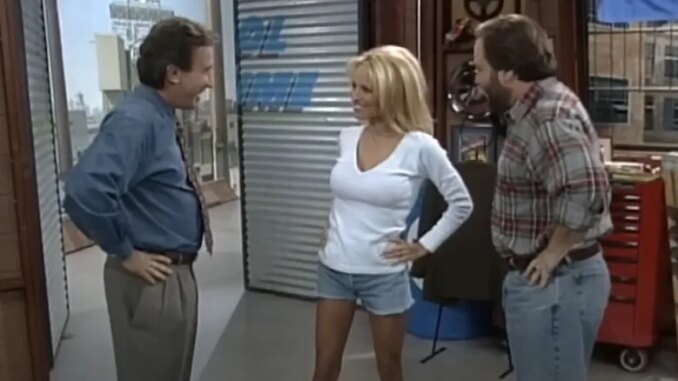
The question echoes through the hallowed halls of 90s television trivia, a persistent whisper across the digital ether: "The real reason Pamela Anderson quit Home Improvement." It's a query that promises a salacious exposé, a behind-the-scenes drama of Hollywood egos and scheduling conflicts. Yet, the true answer, the real reason, is far more illustrative of how public memory, celebrity identity, and the very fabric of pop culture can warp and blend into something entirely new. Because the real reason Pamela Anderson quit Home Improvement is simpler, more profound, and utterly devoid of behind-the-scenes drama: she was never on it.
This surprising non-truth is, in itself, the most compelling "reason" to explore. For many, the image is vivid: a bombshell blonde, synonymous with 90s allure, gracing the set of Tim "The Tool Man" Taylor's wildly popular sitcom. The "tool girl" assistant, Lisa, played by Pamela Segall (later Pamela Adlon), occupied that very role. Meanwhile, Pamela Anderson Lee, the undisputed queen of Baywatch, was making waves of an entirely different, more aquatic, nature. Two Pamelas, two cultural icons, both blonde, both synonymous with the era, yet occupying vastly different television universes. The misattribution is a fascinating testament to the human mind's penchant for categorization and, sometimes, conflation.
The "real reason" for Anderson's non-departure is, therefore, a case study in cultural osmosis. We live in an age of abundant information, yet also one where narratives often trump facts. The very act of asking why she left implies a shared, albeit incorrect, memory. This collective misremembering isn't born of malice or deliberate deception; it arises from a soup of familiarity. Both Home Improvement and Baywatch were prime-time staples, fixtures in millions of American homes. Pamela Anderson was a household name, instantly recognizable. The "tool girl" was also a pivotal, highly visible character. The mind, seeking efficiency, might simply connect the most famous "Pamela" of the era with a prominent blonde role on a famous show. It's a mental shortcut, a pop culture syllogism that goes something like this: "Famous 90s blonde with a prominent TV role" + "Pamela Anderson is a famous 90s blonde with a prominent TV role" = "Pamela Anderson was the tool girl." The flaw in the logic is brushed aside by the comforting sensation of a familiar fit.
This phenomenon extends beyond mere celebrity mix-ups; it touches upon the very nature of our shared cultural understanding. The "real reason" Pamela Anderson never left Home Improvement is that our collective memory is less like a perfectly cataloged library and more like a vibrant, chaotic, and highly subjective art gallery. Impressions, feelings, and broad strokes of identity often override the precise details. We remember the vibe of the 90s, the archetypes, the dominant figures, and sometimes those archetypes merge. The blonde bombshell of Baywatch and the helpful, attractive assistant of Home Improvement are both roles that fit a certain cultural template of the era, making them susceptible to being folded into one another.
Moreover, the "quitting" narrative itself adds another layer to this illustrative error. Hollywood is rife with stories of actors leaving shows for bigger opportunities, creative differences, or personal reasons. This narrative framework is so ingrained that when a prominent celebrity is vaguely associated with a show they weren't truly a part of, the mind subconsciously seeks a "reason" for their absence from that show. It’s a retroactive rationalization of a fictional event. Pamela Anderson did move on to other ventures, famously Baywatch, then movies and a highly public personal life. The idea of her moving on from a popular show like Home Improvement would align with her career trajectory, even if the premise itself was false.
So, the "real reason" Pamela Anderson quit Home Improvement is not a scandalous revelation, but a profound illustration of how we construct our realities. It's a testament to the power of cultural narratives, the fluidity of public memory, and the fascinating ways in which our brains attempt to make sense of the overwhelming flow of information. It reminds us that sometimes, the most revealing truths are found not in what happened, but in what we think happened, and the subtle, often unconscious, biases that shape our collective understanding of the world. The absence of a real reason serves as its own potent commentary, a quiet reminder that the most intriguing stories are often the ones we inadvertently write ourselves.
